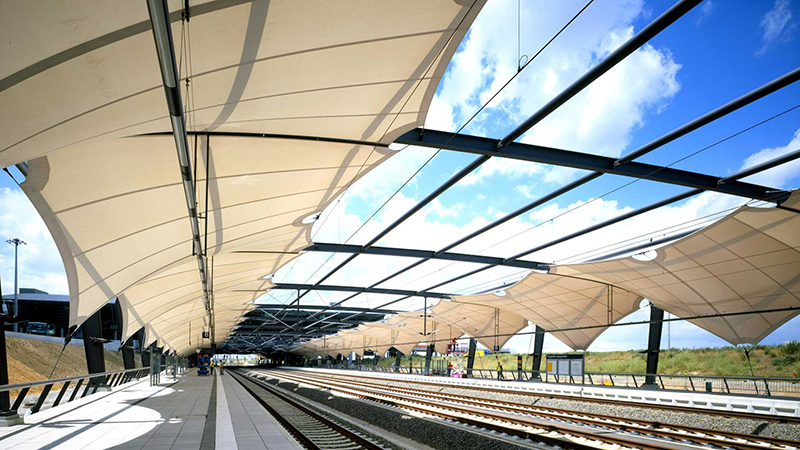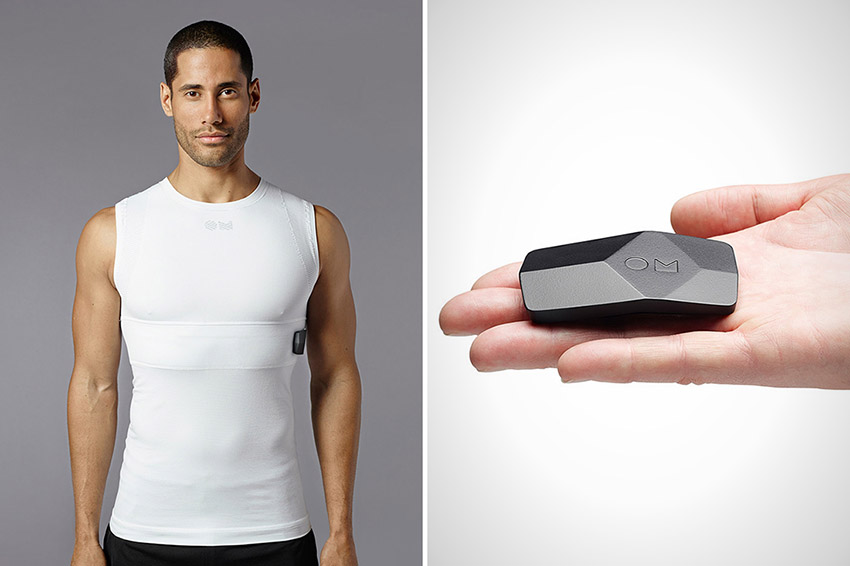Canadian startup OMsignal has introduced a range of smart sports shirts that monitor the wearer’s heart rate, breathing and movement, and then use Bluetooth LE to send the collected data to their smartphone for real-time analysis.
Sportswear that can measure heart rate and other performance metrics, and jackets that can control a smartphone are at the cutting edge of the burgeoning wearables sector. With a focus on technology, design and function, this trend is placing new demands on fabric makers developing e-textiles and other smart garments.
But the growing field of high-tech textiles does not solely involve integrating electronics into yarns and fabrics to produce trendy apparel; technical textiles are offering solutions in a wide range of end-uses using innovative yarns, fabric constructions and finishes.
Rising demand
With the global technical textiles market expected to rise from $143.8 billion in 2014 to $193.2 billion by 2022, the key end-user industries driving demand are forecast to be automotive, medical, agriculture, construction and packaging, especially in the key developing countries of India and China.
A focal point for the future will be functional textiles and nonwovens, from smart textiles, via wearables, to textile-based products for sports, medicine, vehicles and personal protection.
According to a new study by Grand View Research of San Francisco, California, USA, market demand for technical textiles was 26.6 million tons in 2014 and is expected to reach 35.5 million tons by 2022, with a compound annual growth rate (CAGR) of 3.7% from 2015 to 2022.
Transport textiles are the leading application segment, accounting for 15.2% of the total market volume in 2014. Growing demand for high-performance materials from the automotive industry, particularly in the emerging markets of Asia Pacific, Latin America and the Middle East, is expected to remain a key driver for this segment over the next six years.
Medical textiles, meanwhile, are expected to witness the highest growth of 4.6% from 2015 to 2022. Increasing healthcare expenditure in China and India, together with a sophisticated healthcare infrastructure in most parts of Europe and North America, are expected to drive this segment over the forecast period.
Overall, Asia Pacific will dominate the global technical textiles market with a share of more than 45% expected in 2022. Growing industrialization, increasing access to medical care and huge infrastructure spending, particularly in such countries as China, India, Indonesia and Thailand, is expected to drive regional growth, says Grand View Research.
The global technical textiles market is dominated by major multinational corporations that are present across the value chain. These companies have been investing heavily in research and development to counteract volatile petroleum prices and uncertainty regarding the long-term availability of fossil fuel-based materials.
Meanwhile, an increasing number of joint ventures and strategic partnerships are being undertaken to increase production capacity and enhance product portfolios, which is expected to increase the market share of these major players.
Automotive
Automotive textile applications include: floorcoverings, upholstery, belts, tubes and tapes, tire cord, safety belts, airbags, components and filters.
The use of textiles in this sector is increasing particularly as a result of moves to improve passenger safety (e.g., airbags and seatbelts) and comfort.
Further, the drive towards higher fuel efficiency has led to efforts to reduce vehicle weight, which has favored the use of lightweight textiles as well as fiber-based composites.
According to Messe Frankfurt, the use of textiles in vehicles has risen from 20 kg per car in 2,000 to 26 kg in 2012 and is set to rise to 35 kg in 2020, driven partly by the use of composites and the substitution of heavier materials by textiles to reduce both fuel consumption and carbon dioxide emissions.
Airbags are now being extensively employed in vehicles, including driver bags, passenger bags, side-impact bags, curtain bags, knee bags and rollover bags.
To this list can be added: external bags (to protect pedestrians), seatbelt bags (automotive and aviation), bicycle/motorcycle bags and even medical airbags, which are being proposed for protection against bone breakage in older citizens.
Textiles are a key selling point when customers are looking at vehicle comfort and style, as they are a main determinant of aesthetically pleasing interiors. Such materials must also have high performance specifications when it comes to abrasion resistance, fire retardancy and resistance to ultraviolet (UV) light, and they need to be able to be cleaned easily.
Woven and knitted fabrics are likely to continue to account for a predominant share of the global market for automotive textiles. However, nonwovens are gaining market share, with many applications being introduced especially in the non-visible areas of the vehicle, such as sound vibration absorbing materials (e.g., undershields and outer wheel arch liners) as well as filtration.
Meanwhile, environmental reforms in the automotive industry are demanding more recycling of end-of-life vehicles, which will impact the selection of textiles and composite materials in vehicle manufacture, while the use of recycled materials in the sector is growing steadily.

Medical
In the medical and hygiene sector, the use of textiles ranges from simple, disposable products, such as baby diapers, feminine hygiene pads and adult incontinence products, to highly sophisticated items, like advanced wound dressings, sutures, surgical gowns and drapes, and vascular grafts.
The key trends affecting this sector are an ageing population and increased healthcare spending in developed markets, and fertility rates and rising populations in developing markets.
Key technology developments for medical textiles include the development of woven and knitted vascular grafts made from polyethylene terephthalate (PET) or polytetrafluoroethylene (PTFE), embroidered implants, tissue engineering that uses fiber-based scaffolds, nanofibers in wound dressings, and laminated nonwovens for use in hospital gowns and surgical operating drapes.
Agriculture
Agrotextiles include woven, knitted and nonwoven fabrics and other textiles used in agriculture, forestry, horticulture, floriculture (flower farming) and landscape gardening, as well as in fishing and aquaculture (fish farming).
They include fabrics for livestock protection, shading, weed and insect control, and for extending the growing season of plants and crops. The most common agricultural applications are covers for greenhouses and crop protection products.
The main growth driver for the agrotextile sector is the rise in global population, which is increasing the demand for more and better quality food grown in soil that is often compromised.
Another major issue is food security, which is being accentuated by the threat of climate change. As a result, a key driver for the agro-tech sector is to increase productivity by raising crop yields, along with improving the efficiency of land, water, ancillary resources and land management – and conserving the environment.

Construction
Textiles used in construction include concrete reinforcement, façade foundation systems, interior construction, insulation, proofing materials, air conditioning, noise prevention, visual protection, protection against the sun and building safety.
High-strength, high-modulus fabrics are increasingly being used in the building and construction industry as a replacement for more traditional materials, such as wood, concrete, masonry and steel.
The mechanical properties of fabrics made with aramid, carbon and glass fibers, combined with cross-linking resin systems to form a composite, provide civil engineers with a range of new materials that offer high strength-to-weight, high stiffness-to-weight and extreme flexibility in design and use.
A growing sector is the use of textile membranes for roof construction (textile architecture). In particular, polyvinylchloride (PVC) coated high-tenacity polyester, Teflon-coated glass fiber fabrics and silicone-coated polyester are used for their low creep properties. Examples of such constructions are found in football stadiums, airports and hotels.
Packaging
A small but growing sector is in the use of textiles to contain, carry, store or protect goods. Materials can range from heavyweight wovens for bags, sacks and carpets to lightweight nonwovens for durable packaging used to wrap food and industrial products; the sector also includes soft luggage.
A major trend in packaging has been the development of flexible intermediate bulk containers (FIBCs). These are generally produced from either tubular or flat polypropylene (PP) woven fabrics, which can be coated or uncoated.
Environmental concerns and stricter regulations are favoring the use of recycled or biodegradable materials for the packaging industry, and this is likely to impact manufacturers of packaging textiles.
Smart textiles
Perhaps the most exciting developments can be found in the field of smart and electronic textiles (e-textiles), which encompass apparel, furnishing and technical textile applications.
Such materials are increasingly being used in healthcare (e.g., home health monitoring), sports and fitness, fashion and entertainment, personal protection and military/defense clothing.
Many of these end-uses have moved beyond the research and development phase and are now being seen in commercial mass-market products. Examples include textiles that contain lighting systems, either for decorative effects or for treating neonatal jaundice.
According to Frost & Sullivan, smart textiles are materials that can react or adapt to external stimuli or changing environmental conditions. These stimuli can include changes in temperature, moisture, pH, chemical sources, electric or magnetic fields, or stress.
Smart textiles are a key element of wearable electronics (i.e., devices small enough to be worn on the body), which are proliferating in the market. Advanced products can have embedded computing, digital components, electronics, energy supply and sensors.
The main factors driving developments in this sector are:
- The introduction of new types of fibers and structures, such as conductive materials and sensors
- The miniaturization of electronic components, which makes it possible to integrate electronics into textile structures and products
- The use of wireless technologies, which enables the device to be wearable and at the same time communicate with other devices, such as computers or mobile phones
Smart materials can include optical fibers, conductive polymers, metals or nanoparticle coatings to provide, for instance, water repellency, UV protection, self-cleaning or antibacterial properties.
Promising materials for smart textiles include carbon nanotubes for enhancing mechanical properties, embedded fiber optics for healthcare monitoring and photovoltaic fibers for supplying energy.
Future applications could include automotive smart textile interfaces, such as an electroluminescent pattern on the steering wheel to inform the driver about ecological driving performance or a fatigue detection interface (e.g., a thermochromic pattern on the dashboard to notify drivers about their physical condition).
Other possible end-uses include robotics (e.g., e-textiles that allow humanoid robots to match their color to those they are among), security and architecture (e.g., hospital interiors).


